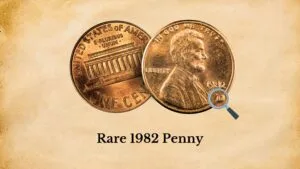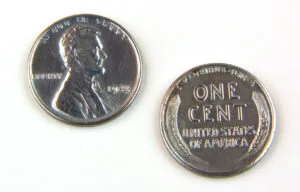The 1864 2-cent coin might have a low face value, but being one of the first coins to use an inscribed motto, a specialty of modern American coins, it’s quite precious!
And, since Congress minted it during the Civil War, the coin used unique mints & motifs, standing out from the other cents.
But what attracts collectors more is their unique motto varieties, and errors that highlight the material shortages, budget & simple designs of old, war-struck America. So, if you want to analyze such features and values of old 1864 2-cent coins, this is the value guide you need!
Key Takeaways
- Old 1864 2-cent coins don’t have any mint marks. But you can identify them by their shield-like motifs, mint year, and motto on the obverse.
- Among the large & small motto cents, the small ones cost more due to their low mintage and compact scripts.
- Original 1864 2-cent coins with a rare, small motto design & MS 65 or preservation grade value up to $1,700.
- 1864 2-cent coins had two die errors – greased-filled die & rotated die, which make them rare and valuable.
Quick Historical Fact File of the 1864 2-Cent Coin
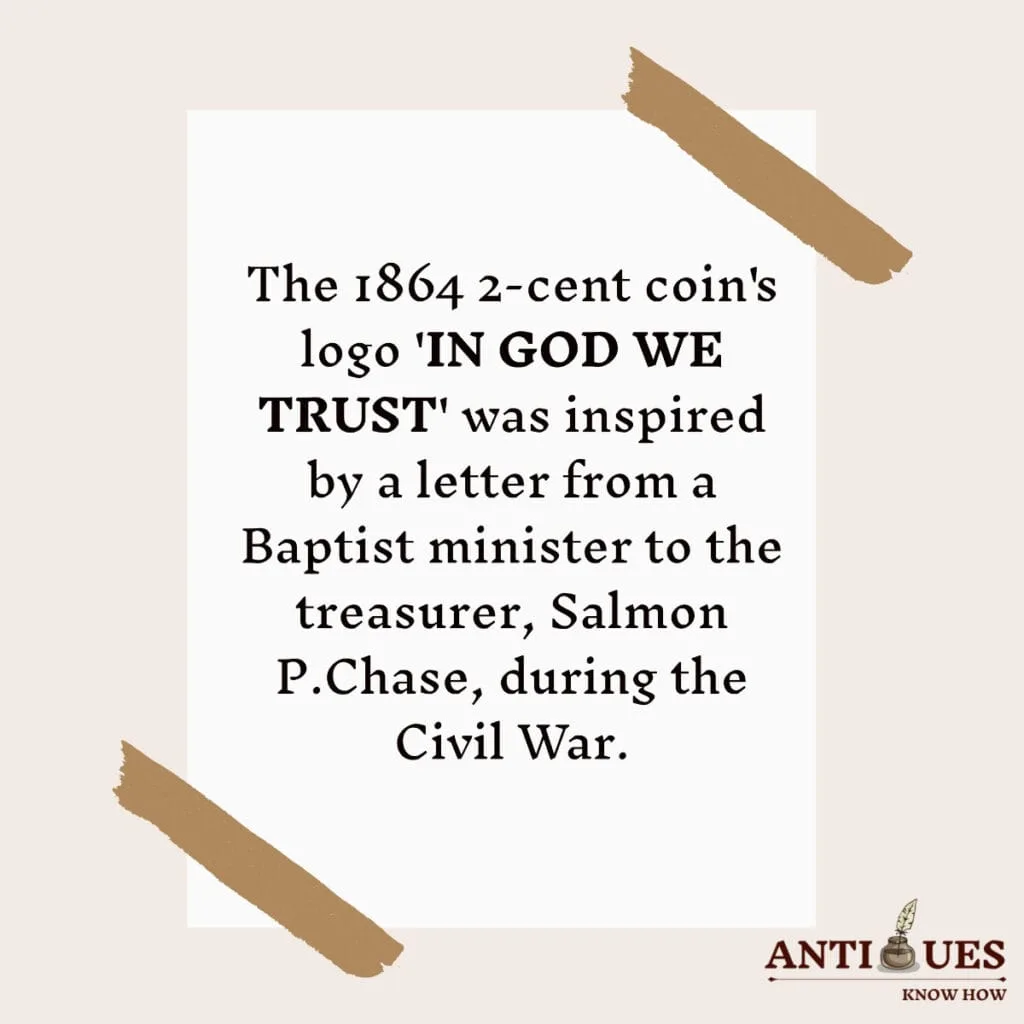
Designed by the fourth official US mint engraver, James B. Longacre, the 2-cent coin faced a turbulent journey since its inception in 1864. Let’s go back and check what went wrong:
- 1862: The US entered a deadly civil war phase and thus was short of finance & copper for ammunition. So, the Congress sought ways to substitute in-circulation 100% copper coins with a mixed alloy coin. Later, they finalized the bronze.
- 1863: James Longacre proposed two designs for the 2-cent coin. One had the head of George Washington, the first President, while the other had shields & arrows. The Congress approved the later design, as it differed from the existing cents.
- 1864: The US mint circulated 2-cent coins using French Bronze, a reddish-brown alloy of 3-parts copper & 1-part tin. Later, the Secretary of the US Treasury, Salmon P. Chase added the motto ‘In God we trust’ on the obverse.
- 1865: The cents started losing popularity due to their grease-filled dies and rotating errors. Subsequently, a new, 5-cent nickel coin, with better shine & finishing, took over the market and is still in circulation.
| The 1864 2-cent Coin | Key Facts |
| Material (Composition) | 95% Copper & 5% Tin |
| Minting Location | Philadelphia |
| Year of Minting | 1864 |
| Weight | 6.22 grams |
| Diameter | 23.00mm |
| Thickness | 1.8mm |
| Design Engraver | James B. Longacre |
| Face Value | 2¢ (2 cents) or $0.02 |
| Mint Marks | None; all are minted in Philadelphia |
| Total Mintage | 19,847,500 |
Design Features of the 1864 2-Cent Coin
The 1864 2-Cent coin went through a lot of government interference in terms of its material, mottos & motifs, finally resulting in the following design:
1. Obverse or Heads Design
You can identify a 1864 2-cent coin with the following design features on its obverse:
- A central, stylized shield with two arrows crossed behind it
- A ribbon banner on top of the shield, with the motto ‘IN GOD WE TRUST’
- An oak & laurel wreath encircled around the shield’s sides
- The mint year, 1864, engraved below the shield
- A raised, dotted border along the rim
2. Reverse or Tails Design
The reverse or tail of the 1864 2-cent coin highlights the following features:
- The denomination ‘2 cents’ is inscribed at the center. The number ‘2’ is large and bold, while the word ‘cents’ is small & uppercased
- Two wheat wreaths encircling the face value mark, with their branches tied together by a ribbon at the bottom
- ‘UNITED STATES OF AMERICA’ relief carved along the upper edge
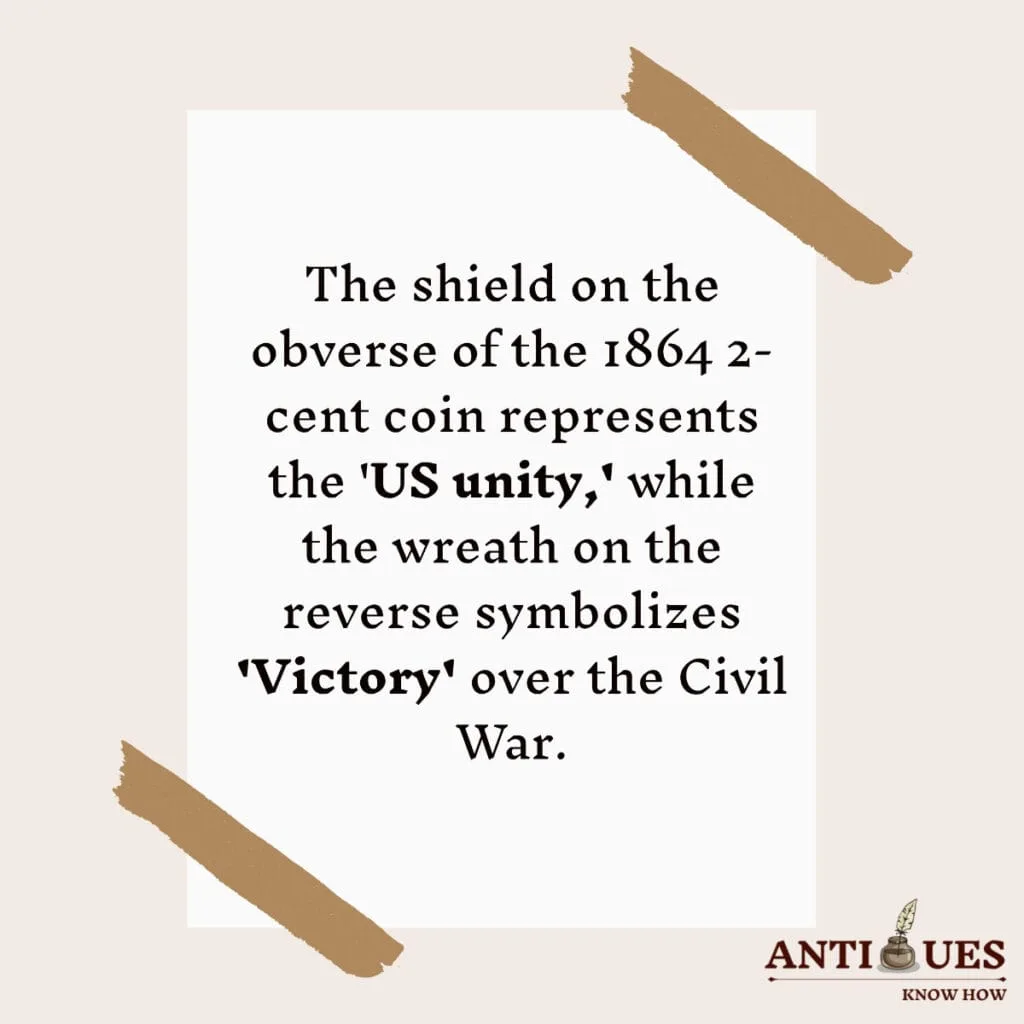
3. Coin Composition & Measurements
The first 1864 coin of the 2-cent series used an alloy mixture of 95% copper & 5% tin. The later 2-cent coins, especially those after 1870, used a similar composition but replaced tin with zinc due to low budget.
But, in general, these coins weigh about 6.22 grams, of which copper amounts to 3.10 grams, while the rest is tin and other nickel impurities. And since they are 1.8mm thick, with a diameter of 23.00mm, these coins are sturdier than other cents of the era!
4. 1864 2 Cent Coin Varieties


The 1864 2-cent coins have the following variations based on their motto’s font & size on the obverse:
- Large Motto Variation: All the 19,822,500 cents minted with this variation have a tall and bold-lettered obverse motto, ‘IN GOD WE TRUST.’ Plus, this version has sharp and pointed arrows & ribbons, hiking the coin’s cost to $80 in an uncirculated state.
- Small Motto Variation: The small-motto variation, limited to less than 65,000 coins, fetches up to $1,000 in an uncirculated state. You can identify them by their narrow, almost connected motto letters & tighter scripts.
Here are a few more differences:
| Large Motto Variation | Small Motto Variation |
| There is a 1mm gap around all the engraved letters of the motto | All the letters in the engraved motto are almost stuck to the ribbon crease |
| The letters in the word ‘WE’ are far apart | The letters of the word ‘WE’ are close, almost connected to each other |
| The motto has a classic serif font | The ‘s’ and ‘t’ letters have no serifs |
| The ‘O’ in ‘GOD’ is elliptical, with the same height as the other letters | The ‘O’ in ‘GOD’ is round and taller than other alphabets |
4 Factors to Value an 1864 2-Cent Coin Rightly
Of course, all 1864 2-cent coins won’t have the same value today. That’s because their final resale cost depends on the grade, mintage, and many more factors, as follows:
1. Condition & Grading
The 1864 2-cent coin had sharp, detailed motifs like the wheat grains and arrows, which turned flat due to its continuous use. And that’s why such plain & even coins don’t cost more than $8 – 10, despite the age.
But if your 1864 2-cent coin is graded or certified by specialized organizations like the NGC or PCGS, it may value up to $500 in its mint state.
Or you can refer to the following features and value table to understand its condition and value:
| 1864 2-cent Coin Grade | Top Features | Estimated Value (Large Motto Variation) | Estimated Value (Small Motto Variation) |
| Average to Very Good (VG) | Completely flat 2D designs, lost leaves, mottos, wreaths & bows | $15 – 50 | $100 – 300 |
| Fine or Very Fine (F or VF) | Weak strike or faded motto & flattened motifs but well-defined ribbon ends, rims, and wreath leaves | $15 – 60 | $250 – 650 |
| Extremely Fine (XF) | Light flattening of the high-relief designs like the arrowheads, their shafts, and the wheat grains | $70 – 110 | $450 – 850 |
| Mint State Grade (MS 60 – 64) | Natural brown or green toning, sharp arrowheads, fonts & domed wheat grains on the reverse | $70 – 500 | $800 – 2,000 |
| Highest Resale for MS 65, 65+, or Preservation Grade | Well-preserved, original state coins with a light, natural patina & sharp details | $3,600 | $3,800 – 5,000 |
2. The 1864 2-cent Proof Coins
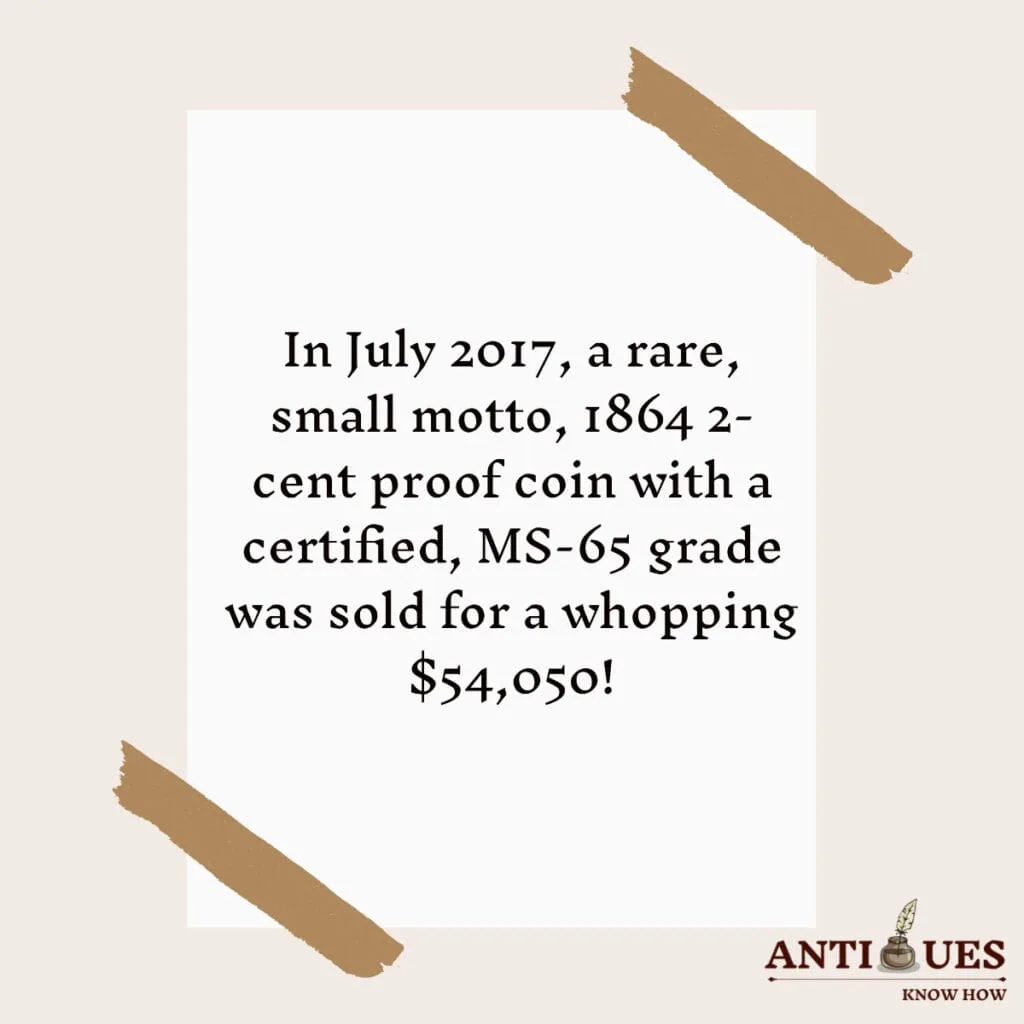
Since most original 2-cent coins turned flat with age, the Philadelphia Mint produced 7,000 proof coins for collectors in 1873. Most of them looked like the original coins but had a shiny, mirror-like finish that hiked their cost up to $5,200 for the RB (red-brown) strike grade.
However, the rare, PCGS-graded coins of a superior BN (brown) strike have been sold for up to $11,000.
Here’s what an 1864 2-cent proof coin looks like:
- No mint mark, as all of them were minted in the Philadelphia mint
- Shiny, mirror-like finish and reddish-brown surfaces
- Cameo or deep cameo surfaces
- A 95% copper, 2.5% zinc & 2.5% tin composition
3. 1864 2-cent Coin Mintage
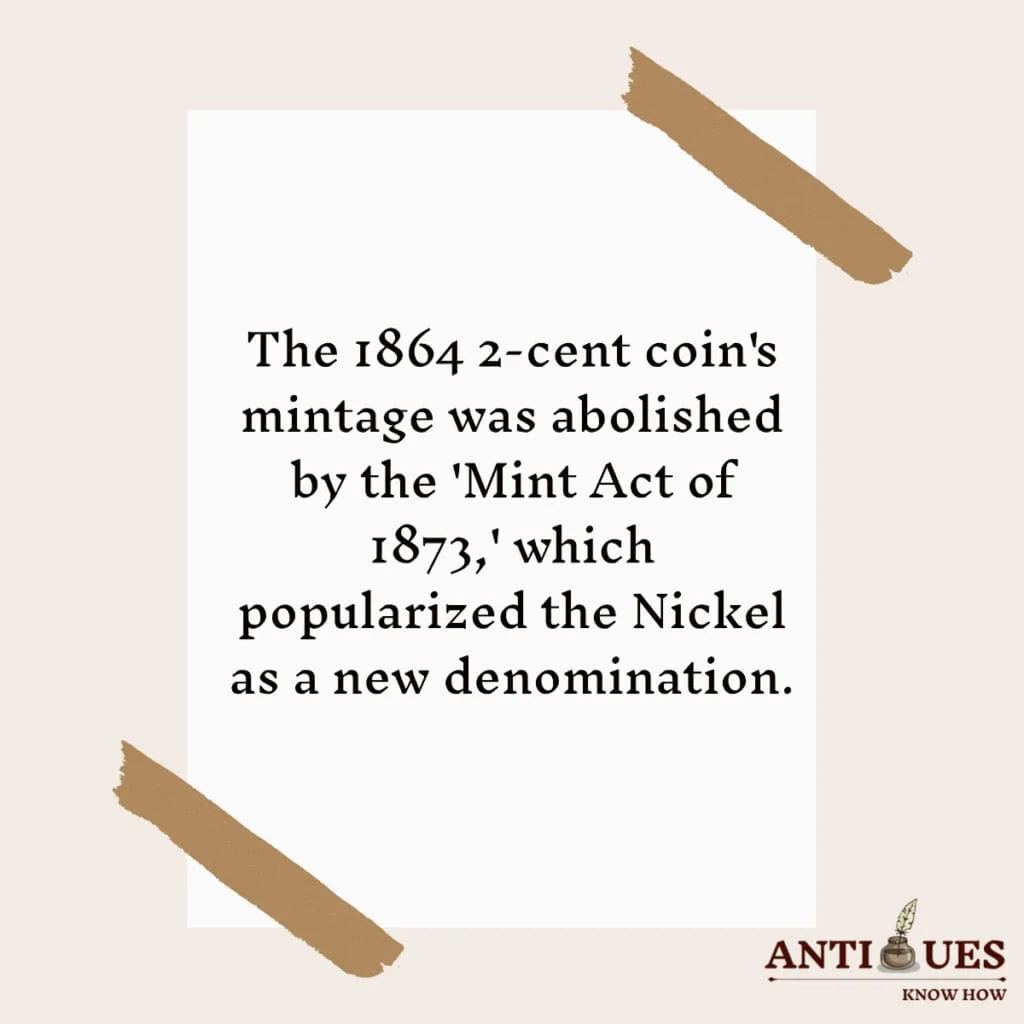
The total mintage of the 1864 2-cents is 19,847,500 coins, but most of them, almost 90%, are the large-motto ones. This makes the small-motto & proof coins rare and highly valued, costing about $1,000 in mint state.
Let’s check the figures:
| 1864 2-cent Coins | Mintage |
| Small Motto Coins | Less than 65,000 coins (exact number not known) |
| Large Motto Coins | 19,822,500 |
| Total Mintage | 19,847,500 coins |
4. Unique Minting Errors in the 1864 2-cent Coin
The 1864 2-cent coin doesn’t have any design errors as such, but the earliest batches might have some die anomalies, making them more collectible. The two most collectible errors are:
- Grease-Filled Die Error: This error was found in some of the earliest mint-state coins due to grease & dust-filled dies. Hence, the coin’s metal didn’t flow to the planchet, and a weak, low-strike coin with faded wreaths and mottos was minted. Usually, this coin costs $80 – 120 in an uncirculated state.
- Rotated Die Error: If the coin’s reverse has a 30 – 60° tilt, with slanting letters or motifs, it might be a rotating die error. And such errors are very valuable, costing up to $285, as quoted by the PCGS.
How to Spot a Real 1864 2-Cent Copper Coin?
If you want a REAL & valuable 2-cent coin, ensure that it doesn’t have any of these following FAKE features:
- Blurry, distorted, or inconsistent edges, often with a double glare
- Different coin diameters & weight
- Might have a thin copper plating that fades on scratching
- Different fonts & spacing
- Chisel marks on the wheat grain wreaths
What is an 1864 2-cent Piece Made Up Of?
The earliest 1864 2-cent pieces used a mixed alloy of 95% copper & 5% tin, but the later ones used 95% copper, 2.5% tin & 2.5% zinc for more profit.
How Many 18864 2-cent Coins Were Minted?
Technically, about 19,822,500 2-cent coins were minted in Philadelphia, of which about 65,000 had the small motto design, while the rest used the large mottos.
While the 1864 2-cent coin might seem like a common, lower denomination coin like the 1896 Indian Head Penny at first glance, it holds tremendous value for its mottos & shield designs. So use this value guide to spot such rare designs and get up to $1,000 in exchange!
Note: This article is intended for informational, educational, and entertainment purposes only. Some images are illustrative and may not represent actual brands, products, or related entities. All trademarks, product names, brand logos, packaging, and other intellectual property referenced remain the exclusive property of their respective owners. Any brand mentions or references are provided solely for descriptive and educational context and do not imply any formal or commercial association.




